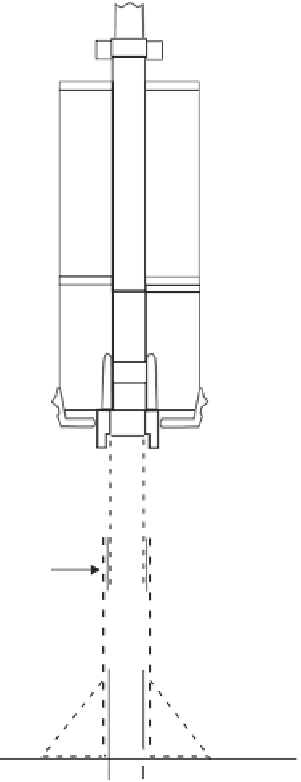Environmental Engineering Reference
In-Depth Information
laboratory to represent the amount of water in a soil. How-
ever, most field measurement of water content provides an
indication of the volume of water relative to the total vol-
ume of soil. Gravimetric water content is commonly used in
soil mechanics; however, volumetric water content becomes
a common representation of the amount of water in a soil
when dealing with unsaturated soil problems. It is important
to be able to convert between gravimetric and volumetric
water content.
There are three primary ways in which water content is
measured in geotechnical engineering. First, the measure-
ment of gravimetric water content is a simple and direct
means; however, it is a destructive measurement in the sense
that a soil sample must be taken into the laboratory for test-
ing. Other methods for the measurement of water content
are indirect methods and are commonly referred to as surro-
gate methods. Second, there are two radiological techniques
that can be used for the measurement of water content:
the neutron scattering technique and the gamma absorp-
tion technique. Third, water content can be derived from the
dielectric properties of a soil using time-domain reflectom-
etry. The radiological and dielectric procedures determine
volumetric water content and do not require an independent
measure of soil density. Details pertaining to technologies
available for the measurement of water content can be found
in the training course manual of the International Atomic
Energy Agency (IAEA, 2008).
Stop
reference plate
Center of
measurement
Adapter
Depth
control
stand
Soil
surface
4.5.2 Radiological-Based Methods
One of the radiological methods utilizes the neutron scatter-
ing methodology to measure volumetric water content. The
technique is based on the interaction of high-energy neutrons
and the nuclei of the hydrogen atoms in the soil. The other
radiological methodology utilizes the attenuation of gamma
rays that are passed through the soil. Both methodologies
have been packaged as portable devices that can be taken
to a field site. Safety and health precautions are necessary
when using any radiological method because of the poten-
tial for receiving doses of radiation. The only time that the
radioactive probe should leave its shield is when it is being
lowered into the access tube for measurements.
Figure 4.89
Schematic of nuclear neutron moisture meter placed
on depth control stand.
does not have the ability to measure the water content in
thin layers within the soil. The access tubes can be made
of a variety of noncorrosive materials ranging from stain-
less steel to plastic, although polyvinylchloride should be
avoided. The diameter of the access tubes are usually about
50mm and the thickness of the tubes is about 1.25 mm. For
geotechnical engineering purposes the neutron probe should
be calibrated for the soils encountered at a particular site.
Nuclear moisture meters are manufactured by Campbell
Pacific Nuclear (model 503DR) and Troxler Electronics Lab-
oratories (model 4300). Nuclear moisture meters appear to
provide the most reliable measurements of water content
based on comparative studies involving a variety of surro-
gate methods (IAEA, 2008). There appears to have been
some reluctance toward the use of nuclear moisture meters
in geotechnical engineering. In part, this may be related to
safety issues associated with the usage of a radioactive probe
and also the inability to automate the recording of periodic
readings.
4.5.2.1 Neutron Scattering Methodology
The hydrogen nuclei have about the same mass as neutrons
in the soil. The nuclei are effective in slowing down neu-
trons upon collision with other nuclei in the soil. The slowed
neutrons in the vicinity of the probe are returned to the sen-
sor in the form of a “count” and can be empirically related
to the volumetric water content of the soil.
Figure 4.89 shows a field setup with the probe and shield
resting on top of an access tube. The probe is lowered into
the access tube and readings are taken at various depths. The
radius of influence in wet soil may be about 150mm whereas
in dry soil it is increased to about 500 mm. This technique




















Search WWH ::

Custom Search